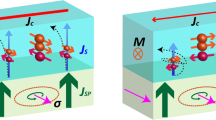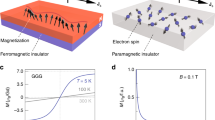Abstract
Injection of spin currents into solids is crucial for exploring spin physics and spintronics1,2. There has been significant progress in recent years in spin injection into high-resistivity materials, for example, semiconductors and organic materials, which uses tunnel barriers to circumvent the impedance mismatch problem3,4,5,6,7,8,9,10,11,12,13,14; the impedance mismatch between ferromagnetic metals and high-resistivity materials drastically limits the spin-injection efficiency15. However, because of this problem, there is no route for spin injection into these materials through low-resistivity interfaces, that is, Ohmic contacts, even though this promises an easy and versatile pathway for spin injection without the need for growing high-quality tunnel barriers. Here we show experimental evidence that spin pumping enables spin injection free from this condition; room-temperature spin injection into GaAs from Ni81Fe19 through an Ohmic contact is demonstrated through dynamical spin exchange. Furthermore, we demonstrate that this exchange can be controlled electrically by applying a bias voltage across a Ni81Fe19/GaAs interface, enabling electric tuning of the spin-pumping efficiency.
This is a preview of subscription content, access via your institution
Access options
Subscribe to this journal
Receive 12 print issues and online access
$259.00 per year
only $21.58 per issue
Buy this article
- Purchase on Springer Link
- Instant access to full article PDF
Prices may be subject to local taxes which are calculated during checkout




Similar content being viewed by others
References
Žutić, I., Fabian, J. & Das Sarma, S. Spintronics: Fundamentals and applications. Rev. Mod. Phys. 76, 323–410 (2004).
Awschalom, D. D. & Flatté, M. E. Challenges for semiconductor spintronics. Nature Phys. 3, 153–159 (2007).
Rashba, E. I. Theory of electrical spin injection: Tunnel contacts as a solution of the conductivity mismatch problem. Phys. Rev. B 62, R16267–R16270 (2000).
Zhu, H. J. et al. Room-temperature spin injection from Fe into GaAs. Phys. Rev. Lett. 87, 016601 (2001).
Crooker, S. A. et al. Imaging spin transport in lateral ferromagnet/semiconductor structures. Science 309, 2191–2195 (2005).
Appelbaum, I., Huang, B. & Monsma, D. J. Electronic measurement and control of spin transport in silicon. Nature 447, 295–298 (2007).
Jonker, B. T., Kioseoglou, G., Hanbicki, A. T., Li, C. H. & Thompson, P. E. Electrical spin-injection into silicon from a ferromagnetic metal/tunnel barrier contact. Nature Phys. 3, 542–546 (2007).
Lou, X. et al. Electrical detection of spin transport in lateral ferromagnet–semiconductor devices. Nature Phys. 3, 197–202 (2007).
Dash, S. P., Sharma, S., Patel, R. S., de Jong, M. P. & Jansen, R. Electrical creation of spin polarization in silicon at room temperature. Nature 462, 491–494 (2009).
Jiang, X. et al. Highly spin-polarized room-temperature tunnel injector for semiconductor spintronics using MgO(100). Phys. Rev. Lett. 94, 056601 (2005).
Xiong, Z. H., Wu, D., Vardeny, Z. V. & Shi, J. Giant magnetoresistance in organic spin-valves. Nature 427, 821–824 (2004).
Tombros, N., Jozsa, C., Popinciuc, M., Jonkman, H. T. & van Wees, B. J. Electronic spin transport and spin precession in single graphene layers at room temperature. Nature 448, 571–574 (2007).
Lou, X. et al. Electrical detection of spin accumulation at a ferromagnet–semiconductor interface. Phys. Rev. Lett. 96, 176603 (2006).
Tran, M. et al. Enhancement of the spin accumulation at the interface between a spin-polarized tunnel junction and a semiconductor. Phys. Rev. Lett. 102, 036601 (2009).
Schmidt, G., Ferrand, D., Molenkamp, L. W., Filip, A. T. & van Wees, B. J. Fundamental obstacle for electrical spin injection from a ferromagnetic metal into a diffusive semiconductor. Phys. Rev. B 62, R4790–R4793 (2000).
Tserkovnyak, Y., Brataas, A. & Bauer, G. E. W. Enhanced Gilbert damping in thin ferromagnetic films. Phys. Rev. Lett. 88, 117601 (2002).
Brataas, A., Tserkovnyak, Y., Bauer, G. E. W. & Halperin, B. I. Spin battery operated by ferromagnetic resonance. Phys. Rev. B 66, 060404(R) (2002).
Mizukami, S., Ando, Y. & Miyazaki, T. Effect of spin diffusion on Gilbert damping for a very thin permalloy layer in Cu/permalloy/Cu/Pt films. Phys. Rev. B 66, 104413 (2002).
Bakun, A. A., Zakharchenya, B. P., Rogachev, A. A., Tkachuk, M. N. & Fleisher, V. G. Observation of a surface photocurrent caused by optical orientation of electrons in a semiconductor. JETP Lett. 40, 1293–1295 (1984).
Saitoh, E., Ueda, M., Miyajima, H. & Tatara, G. Conversion of spin current into charge current at room temperature: Inverse spin-Hall effect. Appl. Phys. Lett. 88, 182509 (2006).
Kimura, T., Otani, Y., Sato, T., Takahashi, S. & Maekawa, S. Room-temperature reversible spin Hall effect. Phys. Rev. Lett. 98, 156601 (2007).
Valenzuela, S. O. & Tinkham, M. Direct electronic measurement of the spin Hall effect. Nature 442, 176–179 (2006).
Ando, K. et al. Angular dependence of inverse spin-Hall effect induced by spin pumping investigated in a Ni81Fe19/Pt thin film. Phys. Rev. B 78, 014413 (2008).
Kajiwara, Y. et al. Transmission of electrical signals by spin-wave interconversion in a magnetic insulator. Nature 464, 262–266 (2010).
Yu, Z. G. & Flatté, M. E. Electric-field dependent spin diffusion and spin injection into semiconductors. Phys. Rev. B 66, 201202(R) (2002).
Ando, K. et al. Electric manipulation of spin relaxation using the spin Hall effect. Phys. Rev. Lett. 101, 036601 (2008).
Žutić, I., Fabian, J. & Das Sarma, S. Spin-polarized transport in inhomogeneous magnetic semiconductors: Theory of magnetic/nonmagnetic p–n junctions. Phys. Rev. Lett. 88, 066603 (2002).
Trypiniotis, T., Tse, D., Steinmuller, S., Cho, W. & Bland, J. Efficient spin detection across the hybrid Co/GaAs Schottky interface. IEEE Trans. Magn. 43, 2872–2874 (2007).
Sze, S. M. & Ng, K. K. Physics of Semiconductor Devices 3rd edn (Wiley–Interscience, 2006).
Acknowledgements
This work was supported by the Cabinet Office, Government of Japan, through its ‘Funding Program for Next Generation World-Leading Researchers’, a Grant-in-Aid for Research Activity Start-Up (2284005) from MEXT, Japan, a Strategic Information and Communications R&D Promotion Program from MIC (102102001), Japan, a Grant-in-Aid for Scientific Research in Priority Area ‘Creation and control of spin current’ (19048028, 19048009) from MEXT, Japan, a Grant-in-Aid for Scientific Research (A) (21244058) from MEXT, Japan, CREST-JST, Japan, and the Next Generation Supercomputing Project of Nanoscience Program from IMS, Japan.
Author information
Authors and Affiliations
Contributions
K.A. designed the experiment, collected all of the data and analysed the data. E.S. supervised the study. K.A., H.K. and T.T. fabricated the samples. K.A., S.T., J.I., H.K., C.H.W.B. and S.M. developed the explanation of the experiment. K.A. and S.T. wrote the manuscript. All authors discussed the results and commented on the manuscript.
Corresponding author
Ethics declarations
Competing interests
The authors declare no competing financial interests.
Supplementary information
Supplementary Information
Supplementary Information (PDF 542 kb)
Rights and permissions
About this article
Cite this article
Ando, K., Takahashi, S., Ieda, J. et al. Electrically tunable spin injector free from the impedance mismatch problem. Nature Mater 10, 655–659 (2011). https://doi.org/10.1038/nmat3052
Received:
Accepted:
Published:
Issue Date:
DOI: https://doi.org/10.1038/nmat3052
This article is cited by
-
Electrical detection of spin pumping in van der Waals ferromagnetic Cr2Ge2Te6 with low magnetic damping
Nature Communications (2023)
-
Room-temperature spin injection from a ferromagnetic semiconductor
Scientific Reports (2023)
-
All-optical observation of giant spin transparency at the topological insulator BiSbTe1.5Se1.5/Co20Fe60B20 interface
NPG Asia Materials (2023)
-
Magnetic field driven magnetic domains and ferromagnetic resonances in multilayer thin films Ta/FeGaB/Ta for microwave application
Journal of Materials Science (2023)
-
Ultrafast optical observation of spin-pumping induced dynamic exchange coupling in ferromagnetic semiconductor/metal bilayer
Scientific Reports (2022)



